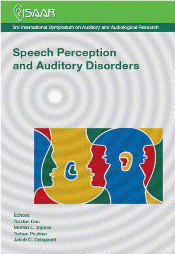Speech-inherent functional onomatopoeia as a basis for emotional analysis of phones
Abstract
Speech sounds (phones) originate in the context of a biological process where the articulators shape the vocal tract into a cascade of cavities and constrictions. This shaping requires muscle activity and these go along with feelings − which the speakers perceive as sitting inside their speech organs (phonetic feelings). The actual feelings depend on the specific form elements that are shaped. Formation of large open cavities associates with a feeling of emptiness, narrow, partly closed cavities are accompanied by the feeling of being pressed, constrictions feel stressed, short thick partitions depressed, long stretched-out partitions filled, satisfied. Each speech sounds designates (symbolically) a specific feeling that is potentially present in the talkers’ perception while producing it. In other words, phones represent onomatopoeic acoustic descriptions of the talkers’ phonetic feelings. It is considered whether this effect may be exploited, for instance, for word recognition, speaker-emotion recognition, sound design, speech synthesis and sound-quality assessment.
References
Berkeley, G. (1710). Treatise on the principles of human knowledge. Jeremy Pepyat, EIR−Dublin. rd
Blauert, J., and Jekosch, U. (2010). “A layer model of sound quality” In: Proc. 3 Int. Conf. Perceptual Quality of Systems, D−Bautzen (to appear also in J. Audio-Eng. Soc. 2011).
Campos, J. J., and Barret, K. C. (1984). “Towards a new understanding of emotions and their development” In: Izard, C. E., Kagan, J., and Zajonc, R. B. (eds.):, Emotion, cognition, and behavior, 229–236, Cambridge Univ. Press, New York.
Di Pellegrino, G., Fadiga, L., Fogassi, L., Gallese, V., and Rizzolatti, G. (1992). “Understanding motor events: a neurophysiological study” Exper. Brain Res. 91, 176–80.
Dominicus, R.-D. (2010). Radikaler Konstruktivismus versus Realismus. Diplomica Verlag, D–Hamburg.
Ekman, P., Friesen, W. V., and Ellworth, P. (1982). “What emotion categories or di- mensions can be observed from facial behaviour?” In: Ekman, P. (ed.) Emo- tion in the human face, pp. 39–55. Cambridge Univ. Press, New York NY.
Flanagan, J.L. (1972). Speech Analysis, Synthesis and Perception, 2nd ed., Springer, Berlin—Heidelberg—New York NY.
Frijda, N.H. (1986). The emotions. Cambridge Univ. Press, NewYork NY.
Galantucci, B. Fowler, C. A., and Turvey, M-T. (2006). “The motor theory of speech perception reviewed” Psychon. Bull. Rev. 13, 361–377
Izard, C. C. E. (1977). Human emotions. Plenum Press, New York NY.
Jekosch, U. (2005). “Assigning meaning to sounds – semiotics in the context of product-sound design” in: J. Blauert (ed.): Communication Acoustics, pp. 193–219, Springer, Berlin–Heidelberg–New York NY.
Juslin, N. P. and Västfjäll, D. (2008). “Emotional responses to music: The need to consider underlying mechanisms” Behav. and Brain Sciences 31, 559–621
Lenneberg, H. E. (1967). Biologische Grundlagen der Sprache (biological founda- tions of language). Suhrkamp, D-Frankfurt/Main.
Liberman, A. M., Cooper, F. S., Shankweiler, D. P., and Studdert–Kennedy, M. (1967). “Perception of speech code”. Psychol. Rev. 74, 431-461.
Libermann, A. M., and Mattingly, I. G. (1989) “A specialization for speech percep- tion” Science 243, 489–494.
Lungwitz, H. (1925). Die Entdeckung der Seele – Allgemeine Psychobiologie (the discovery of the psyche − general psychobiology). De Gruyter, D–Berlin (cited here: 5th edition, De Gruyter, D–Berlin, 1947).
Lungwitz, H. (1933). Die Psychobiologie der Sprache (the psychobiology of speech/language). Brückeverlag Kurt Schmersow, D–Kirchhain (cited here: 3rd, revised edition, Becker, R., ed., Thieme, Stuttgart–New York NY, 2010).
Machleidt, W., Gutjahr, L., and Mügge, A: (1989). Grundgefühle (basic feelings). Springer, Berlin–Heidelberg–New York NY.
Maturana, H. R.: (1987). “Biology of language: the epistemology of reality” In: Miller, G.A., and Lenneberg. E. (eds.), Psychology and biology of language and thought, pp. 27−63. Academic Press, New York NY.
Mees, U. (1985). “What do we mean when we speak of feelings? On the psychologi- cal texture of words denoting emotions” Sprache und Kognition 1, 2–20.
Ortony, A. and Clore, G. L. (1989). “Emotions, moods and conscious awareness”. Cogn. & Emotion 3, 125–137.
Ortony, A. and Turner, T. J. (1990). “What’s basic about basic emotions” Psych. Rev. 97, 315—331.
Panksepp, J. (1982). “Towards a general psychobiological theory of emotions”. Be- hav. and brains sciences. 5, 407–467.
Plutchik, R. (1962). The emotions: facts, theories, and a new model. Random House, New York NY.
Rizzolatti, G. and Craighero, L. (2004). “The mirror-neuron system”. Ann. Rev. Neuroscience 27, 169–192
Additional Files
Published
How to Cite
Issue
Section
License
Authors who publish with this journal agree to the following terms:
a. Authors retain copyright* and grant the journal right of first publication with the work simultaneously licensed under a Creative Commons Attribution License that allows others to share the work with an acknowledgement of the work's authorship and initial publication in this journal.
b. Authors are able to enter into separate, additional contractual arrangements for the non-exclusive distribution of the journal's published version of the work (e.g., post it to an institutional repository or publish it in a book), with an acknowledgement of its initial publication in this journal.
c. Authors are permitted and encouraged to post their work online (e.g., in institutional repositories or on their website) prior to and during the submission process, as it can lead to productive exchanges, as well as earlier and greater citation of published work (See The Effect of Open Access).
*From the 2017 issue onward. The Danavox Jubilee Foundation owns the copyright of all articles published in the 1969-2015 issues. However, authors are still allowed to share the work with an acknowledgement of the work's authorship and initial publication in this journal.


